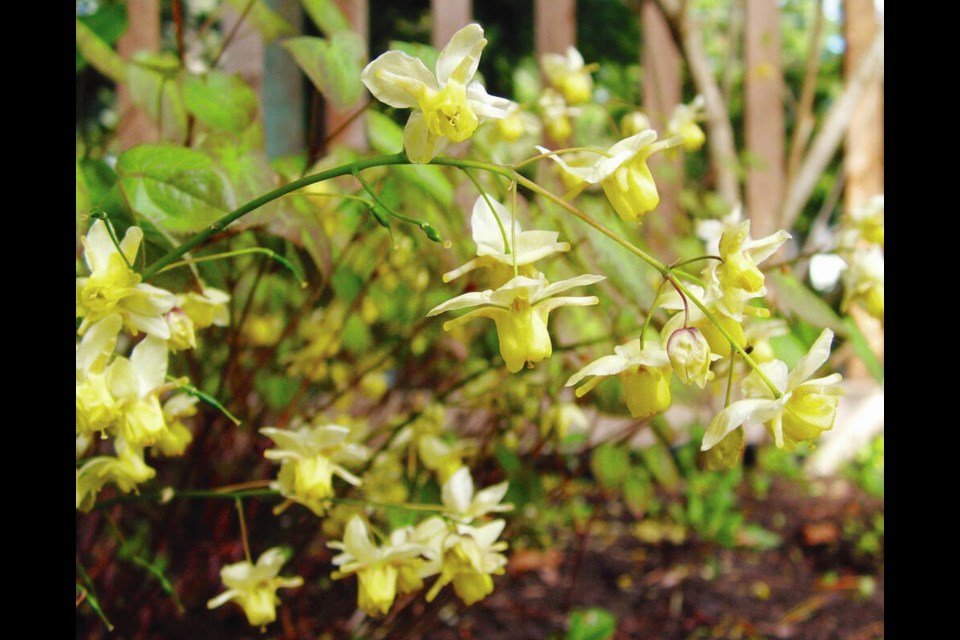Dear Helen: We have a similar problem to one you have described, in your own garden. Like you, we are dealing with Douglas fir roots in our light, sandy soil. The roots are a problem even in the raised beds of our vegetable garden. You have mentioned digging up the roots. How do you remove the invasive roots from your vegetable plots without damaging the soil structure? And how do you deal with the roots in beds with perennials and shrubs?
R.V.
The dilemma you describe is an ongoing issue in the management of my garden, in particular at this time, when I’m preparing plots for the first vegetable plantings.
The choices we both face, between leaving the soil structure and its ecosystem of beneficial organisms intact and disturbing it to remove moisture and nutrient greedy tree roots presents a no-win situation — unless some sort of compromise can be devised.
The only way, sometimes, to deal with sticky situations is to organize a trade-off. We know that in the top layer of soil teaming billions of organisms live and break down organic materials to release nutrients plants need. Digging them up and turning the soil over disrupts that near-magic process.
On the other hand, aggressively invasive tree roots are bound to gobble up the nutrient riches in a soil. What sort of trade-off to make in deciding between these two undesirable effects will depend on the degree of tree root invasiveness in a plot of soil.
Where tree roots have become so thickly entwined in a soil that it is no longer possible to sink a shovel blade into it, it may be time to give up on in-soil plantings and, instead, spread an attractive mulch layer and organize large planters on the area for gardening in. A caution: Raise the planters up on bricks; otherwise, tree roots will infiltrate the drainage holes to fill the pots with roots.
As cedar and fir roots began to be an issue in my vegetable plots, during the early drought years, I began moving plot boundaries closest to the nearby forest farther away from the trees. Now, I’ve begun selective digging only, as I prepare plots for planting. A little test-digging quickly reveals where feeder roots need to be dug out. Usually that’s along plot edges and in corners. Where there are few roots, the soil can be left alone, to be scuffled up lightly to incorporate compost and fertilizer prior to planting.
Where I need to remove clusters of feeder roots, I follow up with an extra generous layer of finished compost, which, I trust, will contain significant numbers of beneficial organisms.
On the issue of dealing with tree roots in perennial and shrub beds, your email mentions finding a few plants that grow well despite the roots. I’ve used the same trial and error process for my root-challenged beds. Like you, I have found Cistus (sun rose), a flowering evergreen shrub, to be enduring in these conditions.
A row of lavender (Phenomenal, from Richters Herbs) in a long, sunny bed beside the driveway does well. Another Mediterranean herb, rosemary, forms an attractive hedge near the forest trees.
In a shaded corner against a section of fence that is crowded on a neighbour’s side by more forest, Irish yews, Epimedium (bishop’s hat) and bigroot geranium (Geranium macrorrhizum) flourish.
To help keep the beds in as decent a condition as possible, in late winter or early spring I scuffle up the soil surfaces between plants, leaving the soil slightly ridged before sprinkling fertilizer and laying a generous layer of a nourishing compost down over top. Every rainfall and watering will help to deliver nutrients to the plants.
GARDEN EVENT
Bonsai demonstration. Dinter Nursery, 2205 Phipps Rd. in Duncan, has postponed the Saturday, Feb. 25 Bonsai Re-potting Demonstration to Saturday, March 11, from 10 a.m. to 12 p.m. because of expected freezing weather on the original date. The nursery’s resident bonsai expert will demonstrate re-potting a Japanese maple. The event will be of interest to bonsai enthusiasts looking for tips on a current project and to people keen of stating their own piece of living art. The event is free, with no registration required. Bring your specimens and questions for discussion between 11 a.m. and 12 p.m. Dress warmly. The event will be in an unheated greenhouse. dinternursery.ca



